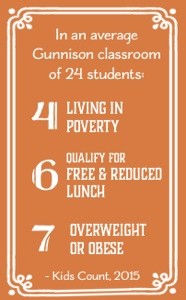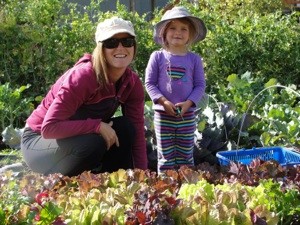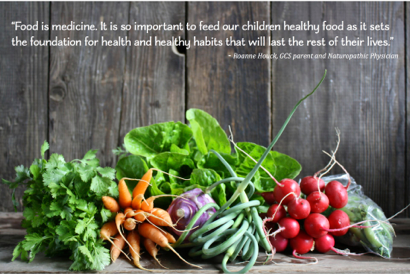HEALTHY CHILDREN ARE BETTER LEARNERS
Parents understand that healthy food choices are fundamentally important for growing kids.
We know this on a common-sense level, and the data backs it up. “Research suggests that students’ health and learning are inextricably linked,” explains Ginny Elrich of the American School Board Journal. “Studies also have shown that food and nutrition programs in schools can boost students’ academic performance and improve behavior and attendance.”
In short, healthy children are better learners. 
Improving children’s health is at the core of Mountain Roots Farm to School Program, now in its fifth year. “Food is medicine. It is so important to feed our children healthy food as it sets the foundation for health and healthy habits that will last the rest of their lives, “ says Roanne Houck, a licensed naturopathic physician in Gunnison. Houck and her husband Jonathan, a Gunnison County Commissioner, are advocates for and supporters of the Mountain Roots Farm to School Program, and often join daughter Iris, 9, and son Billy, 6, for lunch in the school cafeteria. “So much of the food is homemade now,” Houck applauds, “and they have done a great job of including fresh fruits and vegetables into the meals. The chef salads are delicious.”
Across the country, schools with Farm to School programs have nearly twice the national average consumption of fruits and vegetables, a Harvard study shows. Exposure is a key piece to getting kids to eat new, healthy, local foods.
Until very recently, what kids were learning in the classroom about food and nutrition was pretty different from what they were seeing and getting in the cafeteria. Mountain Roots is working to close that gap. In Gunnison and Crested Butte, Farm to School focuses on tangible, hands-on, positive experiences with real food. The idea is that growing organic vegetables in the garden, featuring fresh, local food in the cafeteria, and integrating that with classroom and home education provides a “story” with which children can connect. “If children grow vegetables in a garden, cook them, and meet the farmer who grew them, they are more likely to eat them,” says Kirsten Frazee of Gunnison, who founded a student-run organic vegetable CSA farm program in Minnesota back in 2010, and now brings her two children along while tending her plot in the Cottonwood Community garden. 
Making school meals healthier has the greatest impact on low-income children, who may eat two meals a day at school and depend on school meals as their primary nutrition source. Considering the latest report from Kids Count on Gunnison County, this situation is all too real for more local kids than many realize – in an average Gunnison classroom of 24 students, 4 are living in poverty, 6 qualify for free and reduced lunch, and 7 are overweight or obese. Surprisingly, Gunnison’s childhood poverty rate and childhood obesity rate are higherthan the state average.
“Providing fresher, better tasting, and more nutritious food to kids at school gives all kids – especially the ones who don’t usually go to the farmer’s market or have a garden at home – the the opportunity to try and to like fresh fruits and vegetables,” says Roxana Alvarez, mother of Cash, 10, and Paloma, 8. “These foods can create healthier kids, who go to class energized and ready to learn.”
 But bringing local foods to the school meal program alone is not enough to create lasting behavior change. Farm to School programs are at their strongest when activities take place in the cafeteria, classroom, and community. Edible gardens, farm field trips, farmers’ markets, and school cafeterias are powerful venues for connecting children and families with real food experiences and teaching them about where food come from and how it’s grown. Mountain Roots currently offers the school district direct support, programming, and funding in all three areas. Beth Coop, mother of two boys in Gunnison, went along on a fall field trip her son’s preschool took to one of the Mountain Roots urban gardens. “It was rainbow week, so we talked about all the colors of vegetables, and then they all harvested one giant carrot to take home,” she said. “I was so energized by the enthusiasm from the kids.”
But bringing local foods to the school meal program alone is not enough to create lasting behavior change. Farm to School programs are at their strongest when activities take place in the cafeteria, classroom, and community. Edible gardens, farm field trips, farmers’ markets, and school cafeterias are powerful venues for connecting children and families with real food experiences and teaching them about where food come from and how it’s grown. Mountain Roots currently offers the school district direct support, programming, and funding in all three areas. Beth Coop, mother of two boys in Gunnison, went along on a fall field trip her son’s preschool took to one of the Mountain Roots urban gardens. “It was rainbow week, so we talked about all the colors of vegetables, and then they all harvested one giant carrot to take home,” she said. “I was so energized by the enthusiasm from the kids.”
 Supportive parents hope that as the program grows, the schools will give the cafeteria the attention it deserves as a valuable learning environment – a place that teaches healthy choices by modeling them. Eric and Stacy McPhail, parents of Gage, 12, and Sam, 10, believe that “When kids take an interest in learning about where their food comes from they’re more likely, as adults, to make informed decisions about nutrition and food purchases. “The potential of Farm to School is huge,” they say, “not only are we growing healthier kids, but they are achieving the academic success that the schools are shooting for. We’re nourishing bodies and nourishing minds.”
Supportive parents hope that as the program grows, the schools will give the cafeteria the attention it deserves as a valuable learning environment – a place that teaches healthy choices by modeling them. Eric and Stacy McPhail, parents of Gage, 12, and Sam, 10, believe that “When kids take an interest in learning about where their food comes from they’re more likely, as adults, to make informed decisions about nutrition and food purchases. “The potential of Farm to School is huge,” they say, “not only are we growing healthier kids, but they are achieving the academic success that the schools are shooting for. We’re nourishing bodies and nourishing minds.”

